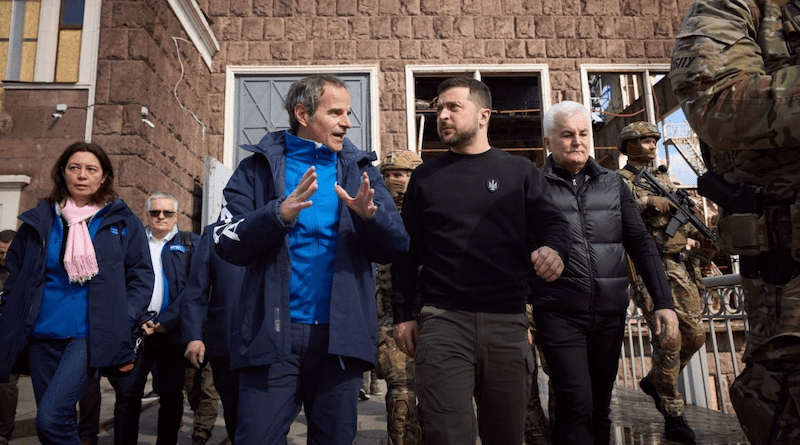Atomic Energy Chief Warns Of Potential Nuclear Reactor Meltdown As Attacks Continue On Power Plant
By VOA
U.N. atomic energy chief Rafael Mariano Grossi met Monday with Ukrainian President Volodymyr Zelenskyy in the Ukrainian city of Zaporizhzhia, about 50 kilometers (30 miles) northeast of the nuclear plant with the same name.
In a tweet, Grossi warned that the Dnipro hydroelectric station is essential to the nuclear safety of the power plant. He also told Zelenskyy that the perilous situation at Europe’s largest nuclear plant “isn’t getting any better” as relentless fighting in the area keeps the facility at risk of a disaster.
Earlier this month, fighting interrupted the power supply to the plant for half a day, forcing staff to activate backup generators.
Grossi had expressed alarm at that development.
“Each time we are rolling a dice,” he told his agency at the time. “And if we allow this to continue time after time, then one day our luck will run out.”
Grossi also reiterated the full support of the International Atomic Energy Agency to the protection of Ukraine’s nuclear facilities.
The Zaporizhzhia Nuclear Power Plant’s six reactors are in shutdown mode, and it is receiving the electricity it needs to prevent a reactor meltdown through just one remaining power line. It has on occasion had to switch to emergency diesel generators to power its essential cooling systems.
Ukraine has called for an extraordinary meeting of the United Nations Security Council in response to Russian President Vladimir Putin’s announcement of plans to station tactical nuclear weapons in Belarus.
Ukraine’s Foreign Ministry said in a statement that Putin’s move was “provocative” and undermined international security.
Russia can halt any action at the Security Council as one of the five veto-holding permanent members. Ukraine said it expects “effective measures” from the other four permanent members — Britain, China, France and the United States — saying those countries “bear primary responsibility for preventing threats of aggression with the use of nuclear weapons.”
Putin announced the deployment of the tactical nuclear weapons Saturday, saying it was warranted because of the West’s increasing military support for Ukrainian forces, including Britain’s decision last week to send armor-piercing rounds containing depleted uranium to Ukraine.
Putin said that Russia’s positioning of tactical nuclear warheads in Belarus was no different than the United States placing nuclear weapons in Belgium, Germany, Italy, the Netherlands and Turkey.
“We are doing what they have been doing for decades, stationing them in certain allied countries, preparing the launch platforms and training their crews,” the Russian leader said.
Putin said Belarusian President Alexander Lukashenko has long asked to have nuclear weapons in his country to counter possible NATO threats from nearby Western allies. Belarus shares borders with three NATO members — Latvia, Lithuania and Poland — while Russia used Belarusian territory as a staging ground to send troops into Ukraine when the invasion began in February of last year.
NATO spokeswoman Oana Lungescu called Russian comparisons to nuclear deployment by NATO members misleading, saying, “Russia’s nuclear rhetoric is dangerous and irresponsible.”
Tactical nuclear weapons can be used on the battlefield and have a short range and a low yield compared with much more powerful nuclear warheads fitted on long-range missiles. Putin said Russia would maintain control over the undisclosed number he sends to Belarus, and construct storage facilities for them by July 1.
The United States said it would “monitor the implications” of Putin’s announcement.
National Security Council spokeswoman Adrienne Watson said that so far Washington hadn’t seen “any indications Russia is preparing to use a nuclear weapon” in its attack on Ukraine.

